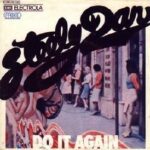 Steely Dan’s Do It Again, released in 1972 as the lead single from their debut album Can’t Buy a Thrill, is a masterclass in blending complex musicianship with pop accessibility. The song’s hypnotic groove, enigmatic lyrics, and jazz-infused instrumentation create a sound that is simultaneously catchy, introspective, and subtly menacing. More than just a rock hit, Do It Again captures the essence of human folly: the tendency to repeat mistakes, succumb to temptation, and chase fleeting desires despite the lessons of experience.
Steely Dan’s Do It Again, released in 1972 as the lead single from their debut album Can’t Buy a Thrill, is a masterclass in blending complex musicianship with pop accessibility. The song’s hypnotic groove, enigmatic lyrics, and jazz-infused instrumentation create a sound that is simultaneously catchy, introspective, and subtly menacing. More than just a rock hit, Do It Again captures the essence of human folly: the tendency to repeat mistakes, succumb to temptation, and chase fleeting desires despite the lessons of experience.
From the very first notes, the listener is drawn into a rhythmic cycle that mirrors the song’s thematic preoccupation with repetition. Its opening electric sitar riff, immediately recognizable and hypnotic, signals a world that is simultaneously alluring and disorienting. The instrumental texture, lush yet precise, sets the stage for Donald Fagen’s sardonic vocals, which narrate tales of temptation, regret, and the strange inevitability of life’s recurring patterns.
Steely Dan: Jazz-Infused Rock Visionaries
Founded by Donald Fagen and Walter Becker in the early 1970s, Steely Dan quickly distinguished themselves with a sound that defied conventional rock categorizations. Their music fused rock, jazz, R&B, and sophisticated studio production, creating compositions that were musically complex yet widely appealing.
Do It Again exemplifies this approach. While accessible to the casual listener due to its catchy groove and memorable chorus, the song is also layered with subtle harmonic shifts, unconventional instrumentation, and meticulous studio production. It represents Steely Dan’s commitment to musical craftsmanship, intellectual lyricism, and emotional ambiguity—a hallmark that would define their career.
Musical Structure and Arrangement
The song’s structure is deceptively simple at first glance, but a closer examination reveals Steely Dan’s signature sophistication. Do It Again opens with the electric sitar, played by Denny Dias, which immediately establishes an otherworldly, slightly dissonant atmosphere. This unconventional choice signals that the song is not merely a standard rock composition—it is an intricate narrative conveyed through both melody and texture.
The rhythm section, anchored by Jeff Baxter on guitar and Jim Hodder on drums, provides a steady, hypnotic groove. Bassist Walter Becker’s melodic bass line interacts fluidly with the percussion, creating an interlocking foundation that is both danceable and subtly complex. The groove evokes a sense of inevitability, mirroring the song’s thematic focus on recurring behavior and repetitive life patterns.
Keyboardist Donald Fagen contributes electric piano textures that are understated yet harmonically sophisticated. Chordal voicings are carefully chosen to produce tension and release, reinforcing the lyrical themes of cyclical temptation and moral ambiguity. Layered backing vocals enhance the sense of narrative depth, subtly echoing Fagen’s lead lines and creating a haunting, almost ritualistic atmosphere.
Lyrics and Themes: Temptation, Consequence, and Cycles
The lyrical content of Do It Again is central to its enduring appeal. Fagen’s narrative voice is wry, detached, and slightly cynical, recounting episodes of desire, transgression, and inevitable return to familiar patterns. Lines such as “In the mornin’ you go gunnin’ for the man who stole your water / And you fire till he is done in but they catch you at the border” depict a cycle of action and consequence, a human tendency to repeat mistakes despite awareness of their outcomes.
The chorus, with its haunting refrain of “You go back, Jack, do it again,” reinforces the sense of repetition and inevitability. The phrase is both a literal narrative hook and a thematic statement, emphasizing the cyclical nature of human behavior. It is simultaneously admonitory, ironic, and almost fatalistic, reflecting Steely Dan’s fascination with moral ambiguity and the complexity of human psychology.
The song’s themes extend beyond personal anecdote to broader existential reflection. Temptation, desire, and repetition are universal experiences, and Steely Dan presents them without judgment, inviting the listener to reflect on their own patterns of behavior. The narrative is rich in detail yet deliberately opaque, encouraging multiple interpretations and ongoing engagement.
Production and Studio Mastery
Steely Dan’s attention to production detail is evident throughout Do It Again. Recorded at The Village Recorder in Los Angeles, the track benefits from meticulous engineering and careful layering of instrumental and vocal elements. Producer Gary Katz and engineer Roger Nichols collaborated with Fagen and Becker to achieve a sound that is both precise and immersive, balancing clarity with depth.
The electric sitar is a prime example of the band’s inventive studio approach. Its tone cuts through the mix while maintaining harmonic integration with the rest of the instrumentation. Similarly, the percussion and bass are recorded with precision, creating a groove that feels both natural and tightly controlled. Every instrument occupies its own sonic space, allowing listeners to hear the intricate interactions between parts without sacrificing the overall cohesiveness of the track.
This attention to detail extends to vocals as well. Fagen’s lead vocal is crisp, expressive, and slightly detached, perfectly complementing the song’s ironic and reflective mood. Backing vocals and subtle harmonies are carefully placed to enhance emotional resonance without overwhelming the lead line. The result is a track that rewards repeated listening, revealing new subtleties with each experience.
Instrumental Innovation
One of the song’s distinguishing features is its instrumental sophistication. The electric sitar provides a hypnotic, slightly dissonant tone that evokes both mystery and tension. This choice was unusual for a rock context at the time, reflecting Steely Dan’s willingness to experiment with unconventional instrumentation.
Guitar work throughout the song alternates between melodic flourishes and rhythmic support, adding both harmonic interest and textural depth. Walter Becker’s bass lines are particularly noteworthy, moving fluidly between supporting the groove and providing melodic counterpoint to the vocal lines. Drums and percussion maintain a steady, propulsive rhythm, creating a sense of forward momentum that mirrors the song’s thematic focus on cyclical behavior.
Keyboard textures are layered with subtlety, providing harmonic sophistication without drawing attention away from the narrative or groove. These instrumental choices collectively create an immersive soundscape that enhances both the emotional and intellectual impact of the song.
Reception and Critical Acclaim
Upon its release, Do It Again achieved commercial and critical success. It reached number six on the Billboard Hot 100 in the United States and became one of Steely Dan’s most recognizable tracks. Critics praised its combination of accessible groove, sophisticated instrumentation, and thought-provoking lyrics.
The song’s success was particularly significant given the complexity of its composition. Unlike many contemporary rock hits, Do It Again did not rely solely on catchy hooks or conventional verse-chorus structures. Instead, its appeal lay in the fusion of groove, narrative, and instrumental sophistication—a combination that would become a defining characteristic of Steely Dan’s work.
The Song’s Place in Steely Dan’s Catalog
Do It Again occupies a unique place in Steely Dan’s discography. As one of the band’s earliest hits, it established the template for their signature style: meticulous production, jazz-influenced harmonics, and lyrics that explore moral ambiguity and human foibles.
The track also reflects the band’s penchant for combining pop accessibility with musical sophistication. While the groove and chorus make it approachable for casual listeners, the harmonic complexity, instrumental nuance, and lyrical ambiguity ensure that it remains rewarding for more attentive, analytical listening. This dual appeal—accessible yet intellectually satisfying—has helped the song endure as a classic of 1970s rock and beyond.
Influence and Legacy
Do It Again has had a lasting impact on rock, jazz-rock, and pop music. Its fusion of sophisticated jazz harmonies with rock sensibilities influenced subsequent artists who sought to combine musical complexity with broad appeal. The track’s hypnotic groove, ironic lyricism, and unconventional instrumentation have inspired musicians across genres, from progressive rock to R&B to alternative pop.
In popular culture, the song has appeared in films, television shows, and commercials, further cementing its status as a classic. Its themes of cyclical behavior, temptation, and human folly remain universally resonant, allowing it to connect with audiences across generations.
Live Performances and Interpretation
Steely Dan’s live performances of Do It Again often featured extended instrumental sections, allowing the musicians to explore improvisational textures while maintaining the hypnotic groove of the studio recording. These live renditions emphasized both the song’s rhythmic propulsion and its melodic sophistication, demonstrating the band’s skill as both composers and performers.
Fagen’s vocal delivery in concert retained the sardonic, detached quality of the studio version, while the band’s dynamic interplay highlighted the richness of the arrangement. Audiences responded to the combination of groove, melody, and narrative, making the song a highlight of Steely Dan’s live repertoire.
Analytical Perspective: Repetition and Cyclical Structure
From an analytical standpoint, the song’s structure reinforces its thematic content. The repetitive groove, cyclical chord progressions, and recurring melodic motifs mirror the lyrical emphasis on repetition and human fallibility. This alignment between form and content demonstrates Steely Dan’s sophisticated compositional approach, where every musical choice serves both aesthetic and narrative purposes.
The electric sitar, with its drone-like qualities, emphasizes the hypnotic, almost ritualistic nature of the song. Bass and percussion lock into interlocking patterns that evoke a sense of inevitability, while harmonic shifts create tension and release that mirror the emotional trajectory of the lyrics. The result is a song that is both intellectually rigorous and viscerally compelling.
Cultural and Artistic Significance
Do It Again remains a touchstone in both popular music and critical discourse. Its exploration of human behavior, sophisticated musicality, and cultural resonance exemplify Steely Dan’s approach to music-making. The track illustrates how rock music can engage with complex themes while remaining accessible, entertaining, and emotionally compelling.
The song’s enduring appeal lies in its universality. Its exploration of temptation, consequence, and cyclical behavior resonates across cultures and eras, while its musical innovation continues to inspire musicians and producers. In short, Do It Again is both a product of its time and a timeless exploration of the human experience.
Conclusion: A Hypnotic Reflection on Human Nature
Steely Dan’s Do It Again is a landmark in 1970s rock, combining musical sophistication, lyrical depth, and cultural resonance into a single, compelling track. Its hypnotic groove, electric sitar riff, and ironic, narrative lyrics create a song that is at once entertaining, intellectually stimulating, and emotionally resonant.
The track exemplifies Steely Dan’s unique ability to fuse jazz, rock, and pop sensibilities into a cohesive sound while exploring themes of human folly, temptation, and cyclical behavior. Its meticulous production, complex instrumentation, and memorable vocal delivery ensure its place as one of the most enduring and influential songs of its era.
For listeners seeking a song that combines groove, narrative, and artistic sophistication, Do It Again remains a benchmark—a reminder of the power of music to entertain, provoke, and reflect the complexities of human nature. In the cycle of musical history, it continues to resonate, inviting each generation to listen, reflect, and perhaps, do it again.


